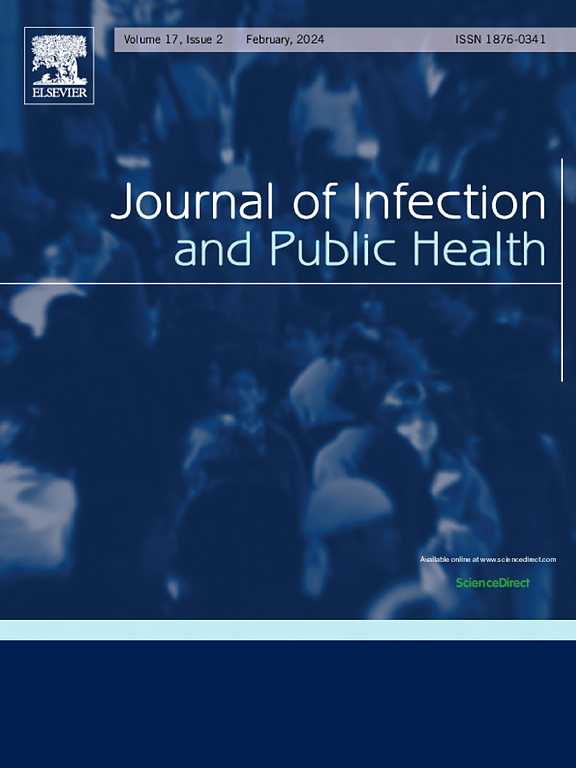非碳青霉烯产生耐碳青霉烯儿童绿脓杆菌:危险因素,分子流行病学和耐药机制。
IF 4.7
3区 医学
Q1 INFECTIOUS DISEASES
引用次数: 0
摘要
背景:目前,对中国儿科耐碳青霉烯类假单胞菌(CRPA)的风险因素、分子流行病学和耐药机制的研究尚不充分:目前对中国儿科耐碳青霉烯类铜绿假单胞菌(CRPA)的风险因素、分子流行病学和耐药机制的研究尚不充分:方法:为了评估流行病学、分子特征和耐药机制,分析了与毒力相关的基因,以及多位点序列分型(MLST)、PCR 和 qRT-PCR:多变量分析发现,长期住院(OR:1.026;95% 置信区间 [CI]:1.004-1.049;P = 0.023)和更多接触酶抑制剂复合制剂(OR:3.165;95% 置信区间 [CI]:1.113-8.999;P = 0.031)是 CRPA 医疗相关感染 (HAI) 的独立风险因素。与非 HAI 组相比,HAI 组的死亡率明显更高(19.1% 对 6.0%,P = 0.021)。对毒力相关基因组合的分析表明,HAI 和非 HAI 分离物中分别有 10 和 15 个不同的基因型,其特征为 exoS-/exoU+ 或 exoS+ /exoU- 基因型,没有分离物同时表现出 exoS+ 和 exoU+ 基因型。感染主要与 CC244 相关,HAI 组的感染率明显更高(72.1% 对 46.3%,P = 0.002)。抗菌药物敏感性测试发现,CC244 + 和 HAI 分离物对所有测试抗生素的耐药性都很高。此外,在 77.9% 的 HAI 分离物和 67.2% 的非 HAI 分离物中观察到了低 oprD 表达,而 ampC 产量增加和 mexB 基因过度表达的情况很少被检测到(所有 P > 0.05):结论:延长住院时间和更多接触酶抑制剂复合疗法被认为是 CRPA HAIs 的独立风险因素。CRPA表现出相当大的遗传多样性,ST主要以CC244为代表,毒力相关基因已经扩散。驱动碳青霉烯耐药性的主要机制涉及外膜孔蛋白oprD的下调,以及oprD突变失活。本文章由计算机程序翻译,如有差异,请以英文原文为准。
Non-carbapenem-producing carbapenem-resistant Pseudomonas aeruginosa in children: Risk factors, molecular epidemiology, and resistance mechanism
Background
The investigation into risk factors, molecular epidemiology, and resistance mechanisms of carbapenem-resistant Pseudomonas aeruginosa (CRPA) in pediatric populations in China is currently inadequate.
Methods
To assess epidemiology, molecular characteristics, and resistance mechanisms, virulence-associated genes were analyzed, alongside multi locus sequence typing (MLST), PCR, and qRT-PCR.
Finding
Multivariate analysis identified prolonged hospitalization (OR: 1.026; 95 % CI: 1.004–1.049; P = 0.023) and increased exposure to enzyme inhibitor complex preparations (OR: 3.165; 95 % confidence interval [CI]: 1.113–8.999; P = 0.031) as independent risk factors for CRPA healthcare-associated infections (HAIs). Mortality rates were significantly higher in the HAI group compared to the non-HAI group (19.1 % vs. 6.0 %, P = 0.021). Analysis of virulence-associated gene combinations revealed 10 and 15 distinct profiles among HAI and non-HAI isolates, respectively, characterized by exoS−/exoU+ or exoS+ /exoU− genotypes, with no isolates exhibiting both exoS+ and exoU+ genotypes concurrently.
Infections predominantly correlated with CC244, with a significantly greater occurrence in the HAI group (72.1 % vs. 46.3 %, P = 0.002). Antimicrobial susceptibility testing identified that both CC244 + and HAI isolates demonstrated elevated resistance across all tested antibiotics. Furthermore, low oprD expression was observed in 77.9 % of HAI isolates and 67.2 % of non-HAI isolates, while increased ampC production and mexB gene overexpression were infrequently detected (all P > 0.05).
Conclusions
Prolonged hospital stays and an increased exposure to enzyme–inhibitor complex therapies were identified as independent risk factors for CRPA HAIs. CRPA demonstrated considerable genetic diversity, with STs predominantly represented by CC244, and virulence-associated genes have spread. The primary mechanism driving carbapenem resistance involved the downregulation of outer membrane porin protein oprD, accompanied by oprD mutation inactivation.
求助全文
通过发布文献求助,成功后即可免费获取论文全文。
去求助
来源期刊

Journal of Infection and Public Health
PUBLIC, ENVIRONMENTAL & OCCUPATIONAL HEALTH -INFECTIOUS DISEASES
CiteScore
13.10
自引率
1.50%
发文量
203
审稿时长
96 days
期刊介绍:
The Journal of Infection and Public Health, first official journal of the Saudi Arabian Ministry of National Guard Health Affairs, King Saud Bin Abdulaziz University for Health Sciences and the Saudi Association for Public Health, aims to be the foremost scientific, peer-reviewed journal encompassing infection prevention and control, microbiology, infectious diseases, public health and the application of healthcare epidemiology to the evaluation of health outcomes. The point of view of the journal is that infection and public health are closely intertwined and that advances in one area will have positive consequences on the other.
The journal will be useful to all health professionals who are partners in the management of patients with communicable diseases, keeping them up to date. The journal is proud to have an international and diverse editorial board that will assist and facilitate the publication of articles that reflect a global view on infection control and public health, as well as emphasizing our focus on supporting the needs of public health practitioners.
It is our aim to improve healthcare by reducing risk of infection and related adverse outcomes by critical review, selection, and dissemination of new and relevant information in the field of infection control, public health and infectious diseases in all healthcare settings and the community.
 求助内容:
求助内容: 应助结果提醒方式:
应助结果提醒方式:


